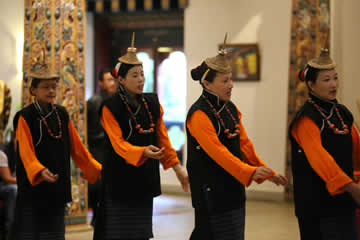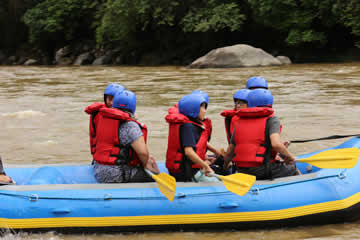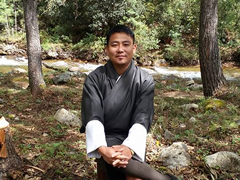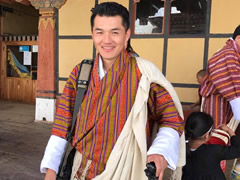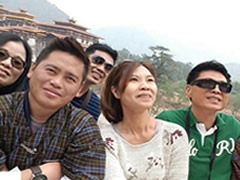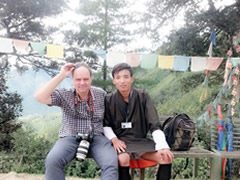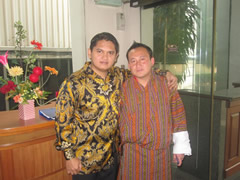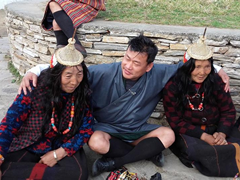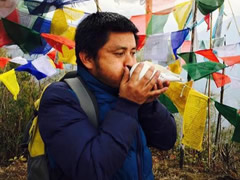Burning Lake
Terton Pema Lingpa
 Pema Lingpa was born in central Bhutanese region known as Bumthang and is believed to be the spiritual son of Guru Rinpoche. His father was Lama Döndrup Zangpo and his mother, Pema Drolma. Pema Lingpa was bought and raised by his Grandfather who was a blacksmith. As a young boy Terton pema Lingpa was taught the art of blacksmith.
Pema Lingpa was born in central Bhutanese region known as Bumthang and is believed to be the spiritual son of Guru Rinpoche. His father was Lama Döndrup Zangpo and his mother, Pema Drolma. Pema Lingpa was bought and raised by his Grandfather who was a blacksmith. As a young boy Terton pema Lingpa was taught the art of blacksmith.
One day at the age of 27, when he went to collect some mushrooms there he meet a stranger who offered him a scroll and disappeared. As a young boy he was taught only the art of blacksmith but do not know how to read and write. After the stranger who offered him a scroll, Pema Lingpa knew how to read and write. It was believed that the stranger was Guru Rinpoche only.
So in that scroll, it was written that you should go down below the river and there is a lake. You should jump in the lake and should discover the treasure hidden by me. So he went down below the river where it looks like a lake and he felt somebody pushed him inside. It was believed that he had seen a temple with 108 doors and there was a woman with only one eye who opened one of the doors and so he came back with a treasure. During that time there was a local king known as Choekkor Dep and Choekkor Dep did not believed about the Terton Pema lingpa’s discovery.
So to make the people believed on him, Terton pema Lingpa gathered all the people including the Choekkor dep in one of the full moon day and made the proclamation “If I am a spiritual son of Guru Rinpoche, I will be coming back with treasures, without getting my cloths wet and my butter lamp will be still on but if I am a spiritual son of a demon let me get drowned and die”.
Pema Lingpa dove in and resurfaced some time later holding a small crafted box, a small sculpture and the butter lamp which was still alight. Choekor Dep got angry and thought he was cheated then he took out his sword and cut the box and there it was believed that there was a statute inside the box and statue’s flew in three directions. So the name of the lake is known as Me bar tsho or the burning lake.
Tamshing Monastery
Tamzhing Monastery
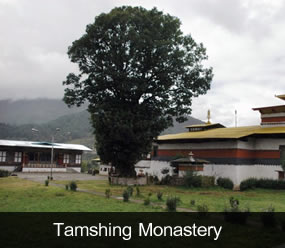 The temple was built by Pema Lingpa– the great Bhutanese Nyingmapa Lama himself in the year 1501, when he was 51 years old. It is located in Choekhor Gewog, about five kilometres from Chamkhar town.
The temple was built by Pema Lingpa– the great Bhutanese Nyingmapa Lama himself in the year 1501, when he was 51 years old. It is located in Choekhor Gewog, about five kilometres from Chamkhar town.
Legend has it that , When Pema Lingpa was digging the foundation, the group of wild boars helped him in laying the foundation. Those groups of wild boars are the emanation of Dorji Phamo (Vajravārāhī). That’s why the temple itself looks like a wild boar and now a days they use to perfrom festival dedicating to Dorji Phamo. Inside the temple there is a statute of Guru Rinpoche and the 8 manifestations of Guru Rinpoche. The statute of the Guru Rinpoche is believed to be built by the Dakinis ( Khandroms ) or the angles from the heaven. Before drown the dakinis flew back to the heaven and that’s why we will see the statute of Guru Rinpoche’s eye looking upward. One thing is that the making of shoes for Guru Rinpoche is not completed.
The wall painting of the temple which is well preserved to date is regarded as one of the oldest in Bhutan. The temple also houses the iron net made by Pema Lingpa when he was 8 years old. It was blessed with his prayers that whoever come in contact with it/carry it and circumambulate the temple will get rid of sins and defilements.
Tamshing is also the original home of sacred peling dances (mask dances) that are performed in annual Tsechus (festivals) throughout Bhutan. Annual festival known as Phalachoedpa is held at its courtyard for three days during the 8th month of the Bhutanese calendar.
Tamshing is a place of daily worship for local communities, and spiritual pilgrimage site of thousands of visitors and tourists. The monastery is headed by H.E Lhalung Sungtrul Rinpoche, the 11th direct incarnation of Pema Lingpa and has over 90 monks. The monastery plays a significant role to the daily lives of the surrounding communities and the people of Bhutan. The monks support the communities in performing religious ceremonies, community services and offering of compassionate counseling.
Kurjey Lhakhang
Kurje Lhakhang
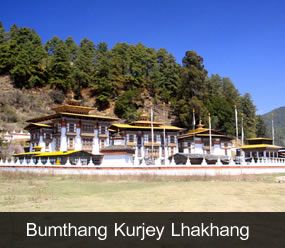 5 km’s north of the district headquarter and 1 km from Jampa Lhakhang, this majestic complex is located on the right bank of the Chamkhar river opposite Tamshing and Khonchogsum lhakhang. The Kurje complex is made up of three buildings facing south surrounded by an enclosure made of 108 chortens.
5 km’s north of the district headquarter and 1 km from Jampa Lhakhang, this majestic complex is located on the right bank of the Chamkhar river opposite Tamshing and Khonchogsum lhakhang. The Kurje complex is made up of three buildings facing south surrounded by an enclosure made of 108 chortens.
History
Kurje is one of the most sacred sites in Bhutan as Guru Rinpoche meditated here and left the imprint (je) of his body (ku) on a rock. In the 8th century, Bumthang was under the rule of a king named Sendha Gyab (alias Sintu Raja) whose home was the ‘iron castle’, Chakhar who was in exile. This king was at war with his southern neighbour, King Naoche. The latter killed Taglamebar - the son of King Sintu Raja, who became so angry that he forgot to worship his personal deity, Shelging Karpo rather he offered the death cows and horses. The angry god Shelging Karpo then captured the soul of the King Sintu Raja. As a last resort, his ministers decided to call Guru Rinpoche, whose supernatural powers were well-known throughout the Himalayas.
Guru Rinpoche first visited to Bhutan in the year 746 AD after the invitation made by the King Sindu Raja. When Guru Rinpoche arrived in Bumthang, he went to a place a short distance north of Chakhar where there was a large rock called Dragmar Dorji Tshekpa. Here lived the deity Shelging Karpo. Guru Rinpoche meditated there for a while, leaving the imprint of his body on the rock. Then he asked the King’s daughter, whom he had taken as his consort, to go and fetch some water in a golden vase. While she was away, he changed into his Eight Manifestations and began to dance in the meadow. So amazing was this spectacle that all the local divinities, except Shelging Karpo, came to watch.
When the king’s daughter came back, Guru Rinpoche transformed her into five princesses, each holding a golden vase in their hand. The vase reflected the sun’s rays directly at Shelging Karpo’s rock. Curious about this unusual flashing, Shelging Karpo decided to take the form of a white lion and come out to see what was going on. This was the moment Guru Rinpoche had been waiting for. Turning himself into a holy griffon, (garuda/jachung), he swooped down, seized Shelging Karpo and forced him to give back the King’s soul. At the same time he made him promise not to cause any trouble for Buddhism and to become a protective deity. Guru Rinpoche planted his pilgrim staff in the ground where it grew into a cypress tree which has a descendant said to stand to this day in front of Kurje Lhakhang. As for Shelging Karpo, he is still the deity of Kurje. King Sendhaka recovered his health and converted to Buddhism.
Guru Rinpoche compelled the two kings to meet each other and make peace at a place in the Black Mountains called Nabji, where a stone pillar commemorates this meeting. This episode constitutes the first conversion to Buddhism of Bumthang.
The actual Kurje complex is made up of three buildings facing south.
The first building on the right (east) is the oldest and was built on the rock where Guru Rinpoche meditated by King Sendha of Bumthang after his conversion to Buddhism. Its structure was rebuilt by Minjur Tenpa in 1652 while he was Trongsa Penlop and before he became the 3rd Desiof Bhutan.
The second building called the Sampa lhundrup temple was built in 1900 by Ugyen Wangchuck, the First King, while he was still the Penlop of Trongsa. The temple was built to house a monumental statue of Guru Rinpoche which was modelled after the advice of the great Nyingmapa lama, the Bakha Trulku, Rigzin Khamsum Yondrol.
A third building, the Ka Gon Phur sum lhakhang, was consecrated in June 1990 by the great master Dilgo Khyentse Rinpoche (d.1991).
The caretakers of the temples are usually from the Trongsa monastic community. Some of the monks from Trongsa dzong spend the summer at Kurje and perform numerous rituals including a Tsechu festival on the 10th day of the 5th Bhutanese month when a thangka is unfurled.
Since 1990, the Royal Grandmother Ashi Kesang Choeden Wangchuck sponsors in the 4th Bhutanese month a ceremony (Grub) for the well-being of the Kings and the country in the Ka Gon Phur sum lhakhang.
The kings and some royal family members are cremated in Kurje.
Jambay Lhakhang
Jambay Lhakhang
 Jampa lhakhang is a walled one-storey low complex built on a plateau above the river Chamkhar. It is one km south of Kuje monastic complex and four kilometers north of the district headquarter. Jambay Lhakhang is said to be one of the 108 temples built by the Tibetan King Songtsen Goenpo in 659 AD on a single day to pin down an ogress to earth forever.
Jampa lhakhang is a walled one-storey low complex built on a plateau above the river Chamkhar. It is one km south of Kuje monastic complex and four kilometers north of the district headquarter. Jambay Lhakhang is said to be one of the 108 temples built by the Tibetan King Songtsen Goenpo in 659 AD on a single day to pin down an ogress to earth forever.
When Guru Rinpoche came to Bhutan, it is said that he preached the teachings of the Kagye cycle to King Sintu Raja and his court from the roof of the temple. The temple of Jambay Lhakhang was later restored by Sendhu Raja after Guru restored his life force.
History
During the 7th Century there lived a Tibetan King known as Songtsen Gempo. He sent his wisest minister Lynpo Garab to compete for the hand of princes of China ‘ Azhi Jazo’ The princes was very beautiful and possess the every quality of dakiness. Her father wanted not a rich husband but the wise husband for his daughter.
So they held a big competition in china where people came from the four corners of the world to win her daughter Azhi Jazo. Among all the participants, Tibetan minister proofed to be the wisest. In a last task, all the competitors were asked to pass a thread from one end of the conch shell to another end. So the Tibetan ministers with his great idea tied the thread to an ant and send it through the hole. The ant successfully completes the threat passing from one end of the conch shell to another.
After winning the hand of princes the minister himself fallen in love with her. On their way back to Tibet, he delayed the journey by going to Tibet through Bhutan. They stopped at Kurtoe where the princes taught the art of weaving to the people of Kurote as a token of gratitude for their hospitality. They reached Tibet in three years’ time.
King Songtsen Gembo visited Tibet with his bride whereby Chinese King presented him with a small statute of the future Buddha (Joe Jamba). On their way back to Tibet , he dropped the statute along the way and could not pick it up even with his might and strength. On consulting the astrology he found out that the statute was pinned down by a huge demoness laying dormant across the Himalaya. If he was to retrieve the statute he has to build 108 lhakhangs or the temples in all her 108 joint on a single day.
Jambay Lhakhang is one of the 108 temples built by him throughout Tibet and theHimalayas to overcome a giant demoness. While Kyichu Lhakhang ( main statute : Joe Shakayamuni) was erected on the demoness’s left foot, and was one of the temples built ‘to subjugate regions beyond the frontiers’, Jampa Lhakhang ( main Statute Joe Jamba) was placed on the left knee and was one of the temples built ‘to subjugate the frontiers’.
A caretaker from the state monastic community of Trongsa dzong looks after the temple, usually for a period of three to five years. The temple is an important pilgrimage place for the Bhutanese and people from all over the Buddhist Himalayas. It is also a daily place of worship for the villagers in its vicinity. The great prayer Monlam chenmo is an important date in the calendar of Bumthang and see hundreds of people gathering every day for one week. The high point of the year is the festival Drup/grub which takes place from the 15th to the 19th of the 9th Bhutanese month. Thousands of people from all over Bumthang and beyond come to watch the religious dances and buy all kinds of things at the fair. Numerous tourists now join them.
Koenchosum Lhakhang
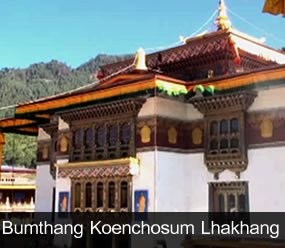 Location
Location
The lhakhang is located in Chumey valley in Bumthang. It is well connected with a paved road and can be reached from the Chamkhar town after ten minutes’ drive.
History
The origin of the temple likely has its roots in the 7th century AD. The current structure, however, dates from the 15th century, when Terton Pema Lingpa restored it. It is believed that a large lake existed underneath the site where Terton Pema Lingpa discovered several treasures, and later built the temple atop it. The small statues of the three Buddha’s (past, present and future) in the sanctuary, are believed to have flown to the site (where the temple is built today) all the way from Khini Monastery in Kurtoe. Hence the name, ‘Kenchosum’: Kencho meaning divine and Sum meaning three. There is a stone pedestal in the courtyard of the temple, upon which a large ancient bell is kept. Legend has it that the bell, when rung, could be heard as far away as Lhasa in Tibet. In the 17th century, Tibetan troops tried to steal the bell. The bell being too heavy for the troops to carry was dropped and suffered a crack.
The bell can still be seen inside the temple, and is considered as one of the main artefacts of the temple. The monastery also holds many relics. The central figure in the temple is the Vairocana (also known as the Nammang, the Buddha of vast space). Towards the left are the Avaloketeshvara and a statue of Guru Rinpoche to the right. The main relic of the monastery is Jowo Jampa (Lord Buddha).
There is also a statue of Terton Pema Lingpa and Longchen Rabjam, a great Tibetan Nyingma scholar who visited Bumthang and founded many temples in the valley.
 Pema Lingpa was born in central Bhutanese region known as Bumthang and is believed to be the spiritual son of Guru Rinpoche. His father was Lama Döndrup Zangpo and his mother, Pema Drolma. Pema Lingpa was bought and raised by his Grandfather who was a blacksmith. As a young boy Terton pema Lingpa was taught the art of blacksmith.
Pema Lingpa was born in central Bhutanese region known as Bumthang and is believed to be the spiritual son of Guru Rinpoche. His father was Lama Döndrup Zangpo and his mother, Pema Drolma. Pema Lingpa was bought and raised by his Grandfather who was a blacksmith. As a young boy Terton pema Lingpa was taught the art of blacksmith. The temple was built by Pema Lingpa– the great Bhutanese Nyingmapa Lama himself in the year 1501, when he was 51 years old. It is located in Choekhor Gewog, about five kilometres from Chamkhar town.
The temple was built by Pema Lingpa– the great Bhutanese Nyingmapa Lama himself in the year 1501, when he was 51 years old. It is located in Choekhor Gewog, about five kilometres from Chamkhar town. 5 km’s north of the district headquarter and 1 km from Jampa Lhakhang, this majestic complex is located on the right bank of the Chamkhar river opposite Tamshing and Khonchogsum lhakhang. The Kurje complex is made up of three buildings facing south surrounded by an enclosure made of 108 chortens.
5 km’s north of the district headquarter and 1 km from Jampa Lhakhang, this majestic complex is located on the right bank of the Chamkhar river opposite Tamshing and Khonchogsum lhakhang. The Kurje complex is made up of three buildings facing south surrounded by an enclosure made of 108 chortens. Jampa lhakhang is a walled one-storey low complex built on a plateau above the river Chamkhar. It is one km south of Kuje monastic complex and four kilometers north of the district headquarter. Jambay Lhakhang is said to be one of the 108 temples built by the Tibetan King Songtsen Goenpo in 659 AD on a single day to pin down an ogress to earth forever.
Jampa lhakhang is a walled one-storey low complex built on a plateau above the river Chamkhar. It is one km south of Kuje monastic complex and four kilometers north of the district headquarter. Jambay Lhakhang is said to be one of the 108 temples built by the Tibetan King Songtsen Goenpo in 659 AD on a single day to pin down an ogress to earth forever. Location
Location

